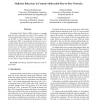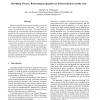832 search results - page 4 / 167 » Effect of Malicious Synchronization |
CNSR
2005
IEEE
13 years 7 months ago
2005
IEEE
Distributed Hash Tables (DHTs) promise to manage huge sets of key-value pairs in a Peer-to-Peer manner. The Content-Addressable Network (CAN) is a prominent variant of DHT. A crit...
CIS
2008
Springer
13 years 7 months ago
2008
Springer
Delivering continuous services in information infrastructures is a major challenge. For system or network administrators, redundancy allocation is one of the best strategies to en...
ICDCS
2005
IEEE
13 years 11 months ago
2005
IEEE
Sensors’ locations play a critical role in many sensor network applications. A number of techniques have been proposed recently to discover the locations of regular sensors base...
ACSAC
2002
IEEE
13 years 10 months ago
2002
IEEE
Modern computer viruses spread incredibly quickly, far faster than human-mediated responses. This greatly increases the damage that they cause. This paper presents an approach to ...
INFOCOM
2009
IEEE
14 years 9 days ago
2009
IEEE
—The performance of randomized network coding can suffer significantly when malicious nodes corrupt the content of the exchanged blocks. Previous work have introduced error corr...


